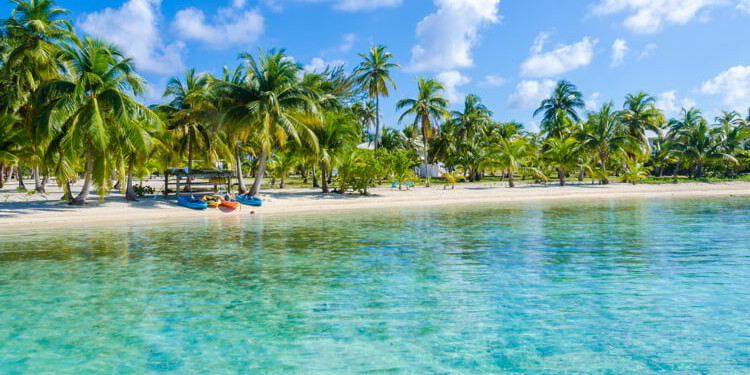Where’s the best place to be when the world ends?
From pandemics to wars to apocalyptic weather, the last few years have taught us to expect the unexpected… and have a backup plan—a place to bug out (or leave in a hurry) to.
If another global catastrophe were to strike, I’d want to be somewhere removed from the chaos and away from other people, but safe… in a country with dependable infrastructure (including solid financial systems and, ideally, great health care)…
Where I could have a bit of space with tillable land and fresh water to live self-sufficiently and harvest energy from natural sources like solar, wind, or water… and where, most importantly, I could live legally for however long I needed…
Belize meets almost all of these criteria. It may be the world’s best bug-out locale, in fact.
First, it clears the most important hurdle of being a bug-out destination: the legal ability to stay there as long as you want or need. It does this by offering several paths to residency.
In fact, it’s one of few countries you can just show up to as a tourist to start the residency process. You just apply for extensions every month to be able to stay there long-term.
This is a good approach if you’re in a hurry, but it’s also a method people use under normal, non-catastrophic conditions.
Next, the Belize mainland specifically offers plenty of space to spread out and live self-sufficiently. The islands, like Ambergris Caye and Caye Caulker, don’t qualify as bug-out options, as they could quickly become resource-scarce.
In northern Belize and the Cayo District, you could live a totally uninterrupted, private life. You’d be free to live exactly as you choose… which is the reason why you find such big Mennonite communities in this part of the country. They bugged out to Belize a long time ago…
Mennonites In Belize
In the 50s, Mennonites left the United States and Canada in search of freedom to live according to their own rules.
That’s exactly what they found in Belize, and to this day, they live independently, free to practice their customs in accordance with their traditions.
They’re so independent from the rest of the population that they’ve even maintained their Old-World mother tongue—Plautdietsch, an archaic form of low German.
Get Your Free Belize Report Today!
Simply enter your email address below and we'll send you our FREE REPORT – Discover Belize: Reef, Ruins, Rivers, And Rain Forest… Plus Easy Residency And Tax-Free Living
Despite their self-imposed isolation, Mennonite communities in places like Spanish Lookout, Orange Walk, and Shipyard thrive, do most of the farming, wood and metal working, and lumbering in Belize. They’re masters of self-sufficiency.
As a rule of thumb, wherever Mennonites have established themselves is probably also a good destination for bugging out.
Their most important considerations, after being legally allowed to live there, are an ideal climate and growing conditions to suit their agriculture-based society.
You Can Be Self-Sufficiency In Belize
With 2,500 hours of sunshine per year, you can power your home with a small solar power system in Belize. Belize is pleasantly warm year-round; temperatures stay above 50°F and below 97°F, so you can live without air conditioning or heating.
It can get too humid at times, but it’s nothing a fan can’t help with. Air conditioning would be nice to have, and a well-insulated home can make the energy required minimal.
With over 100 inches of rainfall per year, you can also become water independent in Belize. You’ll need large cisterns to see you through the dry season. Belize’s high humidity levels make atmospheric water generation a viable option, too.
Belize doesn’t impose any property ownership restrictions on foreigners, and you can find great deals on properties in northern Belize. It’s 25% to 50% less expensive than areas like San Pedro, Placencia, and Hopkins.
You can even get cheap waterfront in this part of the country, though you’ll likely need to install and maintain a road to your property as well as solar power. It’s so remote, utilities aren’t close by.
If you needed a second home quickly, you could take advantage of local Mennonite craftsmanship and buy a tropical hardwood cabin. These can be delivered (by truck) and fitted in a day and cost about US$35,000 for a 67-square-foot cabin. A septic system, landscaping, utility connection, and other finishings cost about US$12,000 more.
Other benefits of Belize as a bug-out destination are the fact that it’s close to the United States (only a two-hour flight from the south), it’s English-speaking, and it has a well-established expat community you can lean on if needed. Also, the Belize dollar is pegged 2:1 to the U.S. dollar, which offers currency stability.
Belize’s downside as a bug-out destination is that its health care options are limited. If you had a serious medical concern, outside of one or two private hospitals in Belize, you’d probably want to seek treatment in neighboring Mexico, where the care is superior.
Also, in remote parts of the mainland, infrastructure and road quality can be dodgy. If you’re aiming to live self-sufficiently anyway, the quality of infrastructure may not affect you so much.
If you do need a car, the best option for Belize’s terrain is an SUV with four-wheel drive. You’ll want a make and model that you can get replacement parts for locally.
Long-time Belize expat John Wiankowski recommends the Mahindra pickup truck (not available in the States). He says it has taken him places where other four-wheel drives have failed.
Or you can do as the Mennonites do and get around by horse and buggy.

Sophia Titley
Belize Insider










